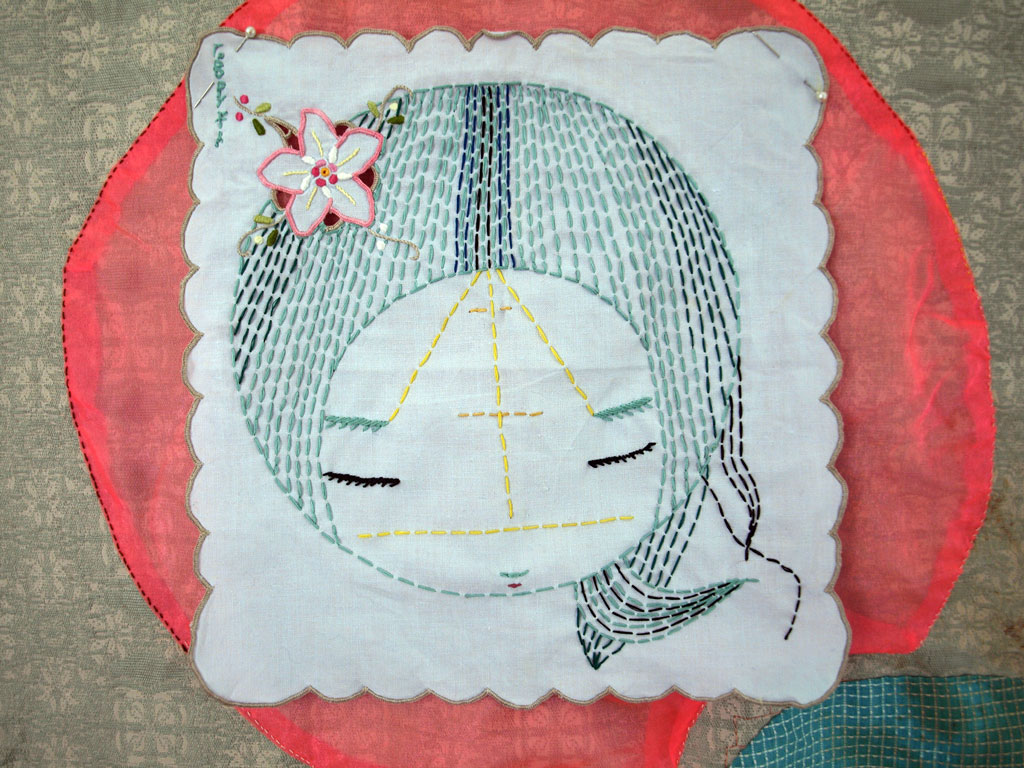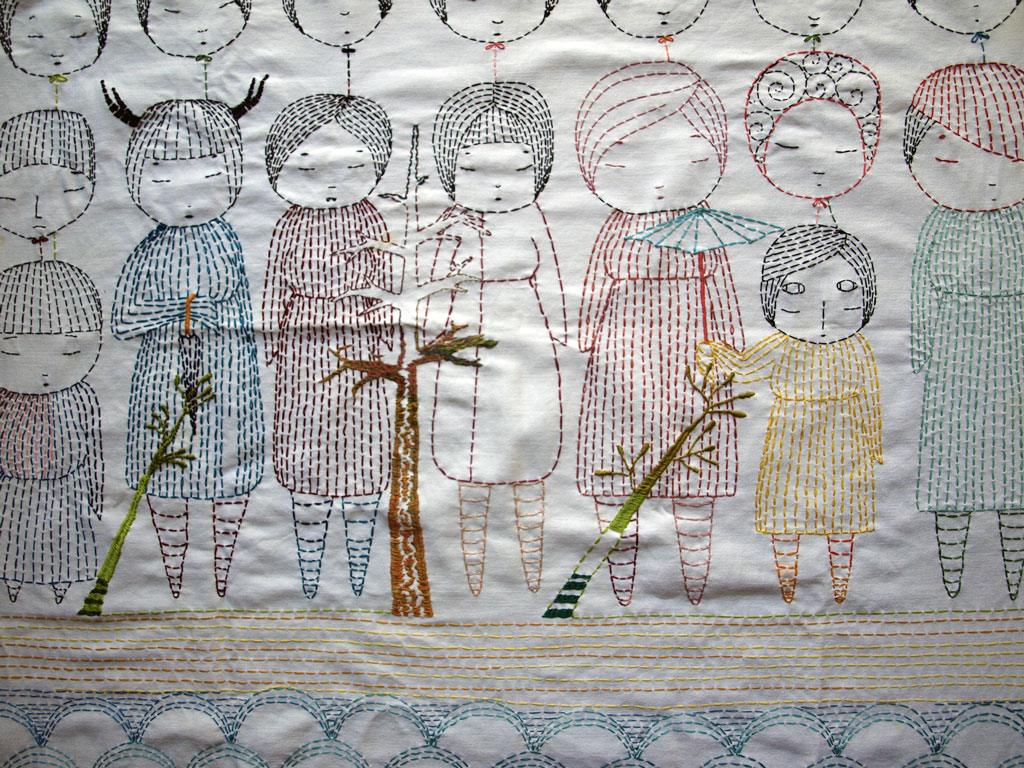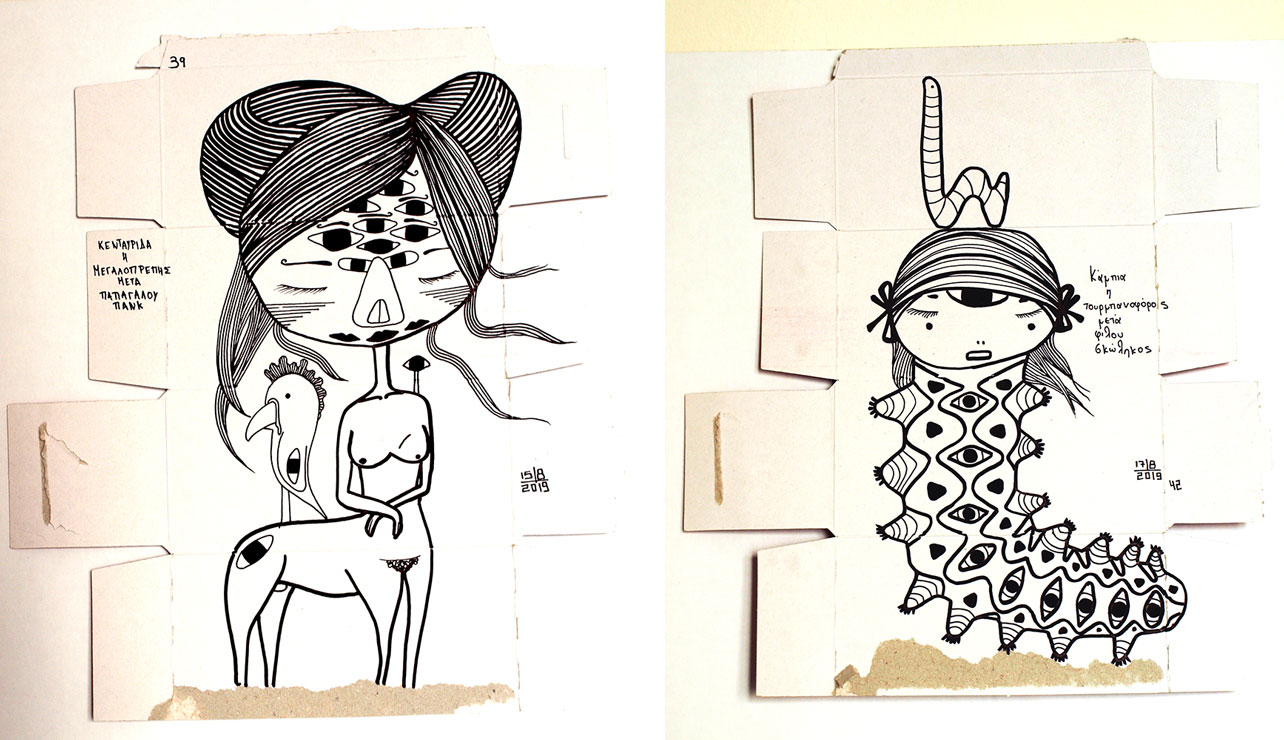IN THE STUDIO: Grigoria Vryttia
 I first met Grigoria Vryttia on June 2019, when she presented me her works on fabrics. At that moment without being unpleasant to me, maybe I was saturated with pictures and information, I wasn’t excited, but there was the strong element of childhood and innocence that provoked me (!) Two months later, when Ι looked at the material again, I realized what was the part that was fascinating me in these works. It was neither the fabric, nor the sewing, the embroidery or the weaving, , elements that interest me in the particular project I’m working on,but that her works refer to Japanese comics. Both the installations and the wall mounted works of Grigoria, as well as her sculptures and figures that just step off into space are like coming from a world of incredibly charm, absolutely rigorous and minimal and at the end extremely cruel and is the Japanese world.
I first met Grigoria Vryttia on June 2019, when she presented me her works on fabrics. At that moment without being unpleasant to me, maybe I was saturated with pictures and information, I wasn’t excited, but there was the strong element of childhood and innocence that provoked me (!) Two months later, when Ι looked at the material again, I realized what was the part that was fascinating me in these works. It was neither the fabric, nor the sewing, the embroidery or the weaving, , elements that interest me in the particular project I’m working on,but that her works refer to Japanese comics. Both the installations and the wall mounted works of Grigoria, as well as her sculptures and figures that just step off into space are like coming from a world of incredibly charm, absolutely rigorous and minimal and at the end extremely cruel and is the Japanese world.
By Efi Michalarou
Photo: Grigoria Vryttia Archive
Your work, not only the new one, but the whole, although it looks like a single section, is multifaceted. It extends from drawing and painting, to sculpture, installations and performance, using heterogeneous media and elements. As we know your initial education was in sculpture and traditional media, how and when did you made your transition?
The traditional approach to teaching sculpture, in the first years in the schools of Fine Arts, in Greece, provides with a sense of emotional security. What we are asked to do is rather precise and I could do that well and with ease. When I entered the fourth year and I had to find my own aesthetic and medium, I froze. For a number of months, all I did was draw in tiny sketchbooks and have long talks with professors and fellow students. Suddenly, everything fell into place. Fabric had always been a medium I enjoyed, ever since I was very young. I had done numerous small objects. Thus I decided to explore its potential in new forms and increase the scale.
The environment is important to you, for that reason you are using in your work recycled materials and elements, emphasizing its protection. What are these? Ηow do you obtain them? and till you intervene? To what point do you manipulate them?
The majority of my materials are upcycled, old magazines and paper, as well as clothes and fabrics. A characteristic example is a series of drawings on food and medicine paper packaging, as well as my most recent works on old tablecloths, tea-towels and doilies. Some were made by older women in my family, others salvaged from thrift-stores. I try to function with a non-consumer attitude, although, there are occasions when an idea demands I buy new materials. The extent to which I alter each material adjusts to the idea that needs to take form.
We met through embroidery, sewing and weaving, that are your main concerns in your last series where you are exploring…
Through my textile works I explore the story that links generations of women-crafters. They have often been looked down upon a patriarchal society. I approach them as surfaces that can host and merge with an original work of art. Thus I alter the state of perception for the work of the previous woman. Although the medium and materials I use vary from time to time, my whole opus is characterized by an explosive use of colour and a focus on contradictions. The contrast between represented body and represented clothing, content and container, gender identities as we experience them as individuals and as a social contract, the full spectrum of feelings and all the contrasting elements that form our multifaceted existence. Often I draw very minimal faces, that are not void of expression, on the contrary, to use Rudolf Arnheims words in a slightly different context: they are mirrors where the spectators can see their fears and desires.
If art is a cure for many of the diseases associated with the human soul, what is the meaning of medicines packages for you? Why you transform them into wonderful meta-comic and fairy tales, using pen and markers?
My personal understanding of sickness and health, is that they are in some extent, a social construction. We would feel much better about ourselves if we perceived it not as if something faulty but as a different state of being. Sickness can cause physical pain but it need not cause sadness. I am speaking from a very personal point of view, because I have an ailment that has sent me to the hospital for major surgery five times, since I was a young adult. At the moment, I take quite a lot of medication. I saw the paper packaging and felt almost obliged to use it in my practice. I had to change the signifier-signified bipole, too.
You believe that “art is a big communication game and the strongest way to recognize ourselves through the other”. Is a consequence of this position, Domatio Social Cooperative Enterprise (SCE) that you are one of its founding members? What is its path and goals?
Domatio Project started as an experiment in 2017 as a very ambitious festival. For a whole month, each day we hosted a different exhibition of official works of art and works of people with disabilities. My voluntary contribution was to create reliefs, so that people with visual impairment could perceive the two-dimensional works, through touch. We had given great focus on accessibility and social inclusion. In 2019 we decided to regroup and form an official business in the form of a co-op, so that we could provide a better opportunity to people as those we met in the original festival, to be represented in an art-space. In Domatio, we are a group of people with two major common features; our love for art and our love for our fellow humans. We host omnifarious events like workshops, book presentations, art shows and festivals in a polymorphic space. Soon, once all this conundrum with covid-19 is over, we will hold our main festival, a new form for the Domatio Project.
Download Greek Version of Interview here.
First Publication: www.dreamideamachine.com
© Interview-Efi Michalarou
Grigoria Vryttia is an interdisciplinary art-practitioner, born in1983 in Greece. Her current location is Athens, Greece. She was trained in traditional sculpture at the dpt of Fine and applied Arts of the school of Fine Arts at the A.U.Th., Greece, from 2002 until 2007. In 2010 she received an MA in Fine Arts, from the Wimbledon College of Art, U.A.L., UK with a scholarship for post-graduate studies from the Michelis Foundation (Greece). Her current practice involves sculpture with textiles and soft materials, painting, drawing, digital arts and collaboration with performers. Occasionally she takes commissions for illustrations, costume adaptation and design. Since 2019 she is a founding member of Domatio co-op. For a full CV and portfolio visit The Evasive Twattwan at http://texturesinart.blogspot.com













